MARIANI’S
Virtual Gourmet
August
9, 2015
NEWSLETTER
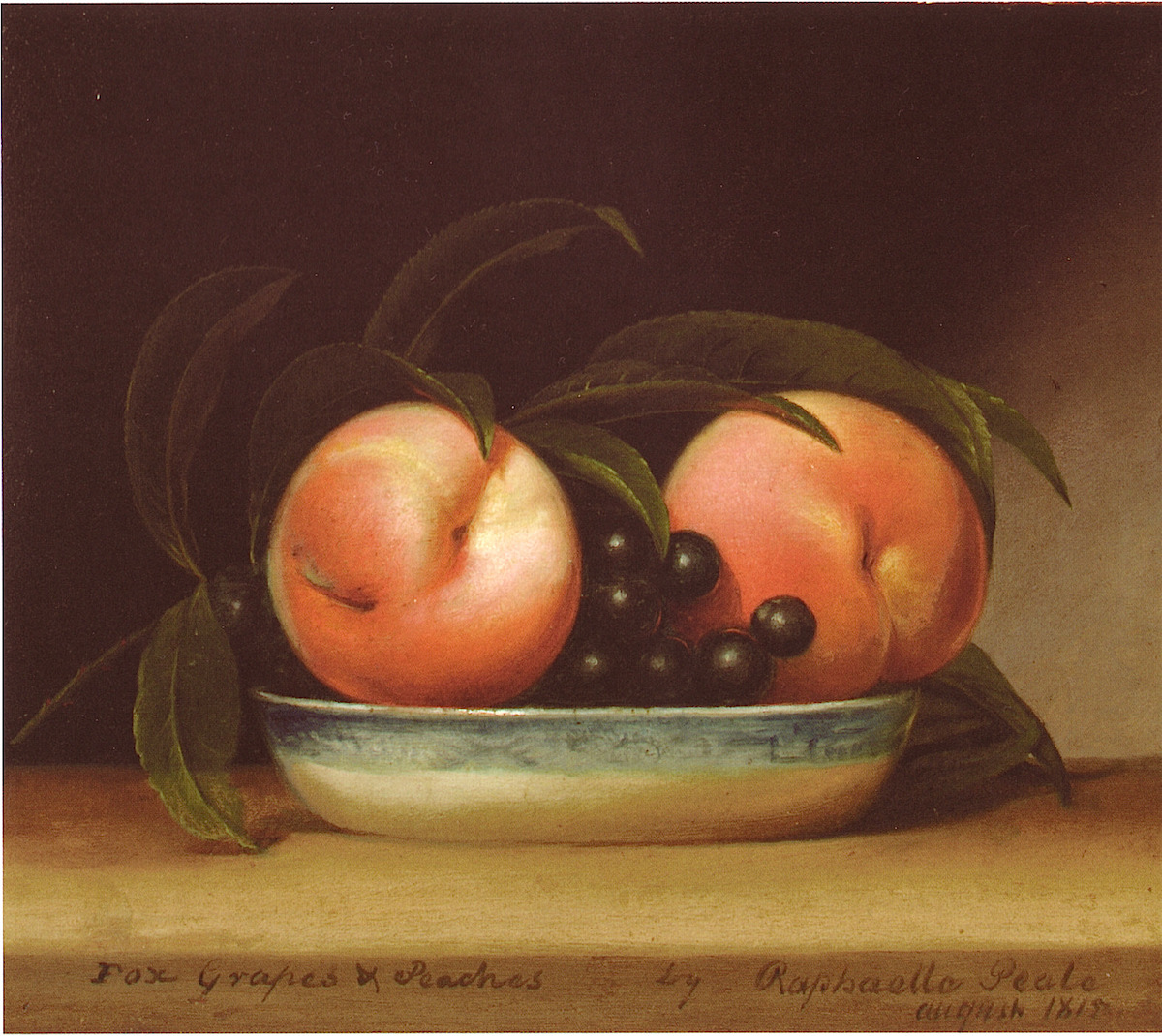
"Fox
Grapes and Peaches" by Raphaelle Peale (1815)
IN THIS ISSUE
MUSIC CITY MEMPHIS
By John Mariani
NEW YORK CORNER
PICHOLINE
By John Mariani
NOTES FROM THE WINE CELLAR
❖❖❖
MUSIC CITY MEMPHIS
By John Mariani
"In the quest to identify the roots of rock `n' roll, all roads lead to Memphis."--Smithsonian Institution
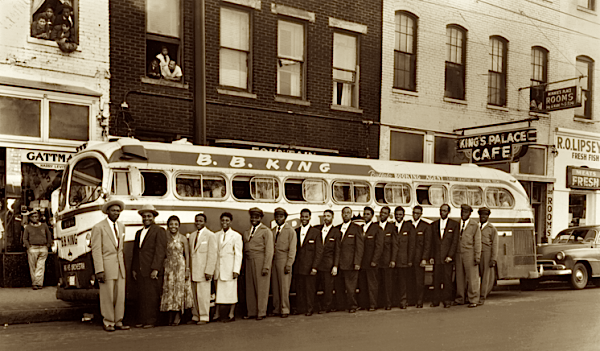
All
you need to do to get a sense of the extraordinary
depth of Memphis’ enduring music culture is to
stroll down Beale Street, look down and, step by
step, read the names on the brass plaques in the
cement: W.C. Handy, B.B. King, Alberta Hunter,
Robert Johnson, Albert King, Elvis Presley, the
Staple Singers, Jerry Lee Lewis, Otis Redding, Sam
and Dave, Justin Timberlake, and 125 more--all of
whom were born in, lived in or recorded in Memphis
over the past century. Few cities could claim
anything like such a group of musicians as
influential as these, and no other city can claim
to be the crucible of the Delta Blues.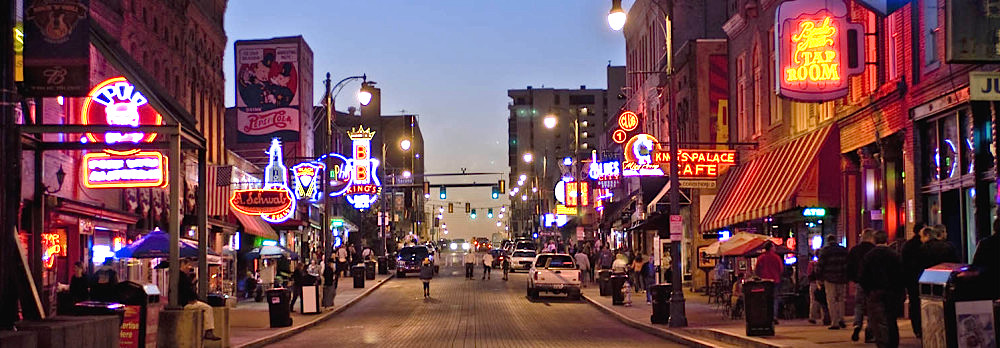
Beale Street was once central to Memphis’s music scene. Bands played on the street as early as the 1860s, and by 1890 Beale had a Grand Opera House (later called the Orpheum). By the 1940s jazz and blues clubs lined the street; B.B. King was called “The Beale Street Blues Boy.” In 1977 an act of Congress declared Beale “Home of the Blues.”
But as early as the
1960s Beale Street was caught in the city’s downward
spiral, with most buildings on the street boarded up
over the next decade. Misguided redevelopment plans
followed and sputtered, so that even though Beale
Street (above)
is still a prime entertainment attraction for
tourists, there’s been little left to suggest this
was ever the true Home of the Blues. This is about
to change: The re-opening of The New Daisy,
previously a 1937 movie theater, brings higher
profile acts than in the past, with a balance of
rock and roll, country and western, and hip hop, in
partnership with Live Nation and Disco Donnie, and
the renovation of The Palace Theater as a concert
and events hall is now underway. And just this month The Memphis
Music Hall of Fame has opened on Beale Street.
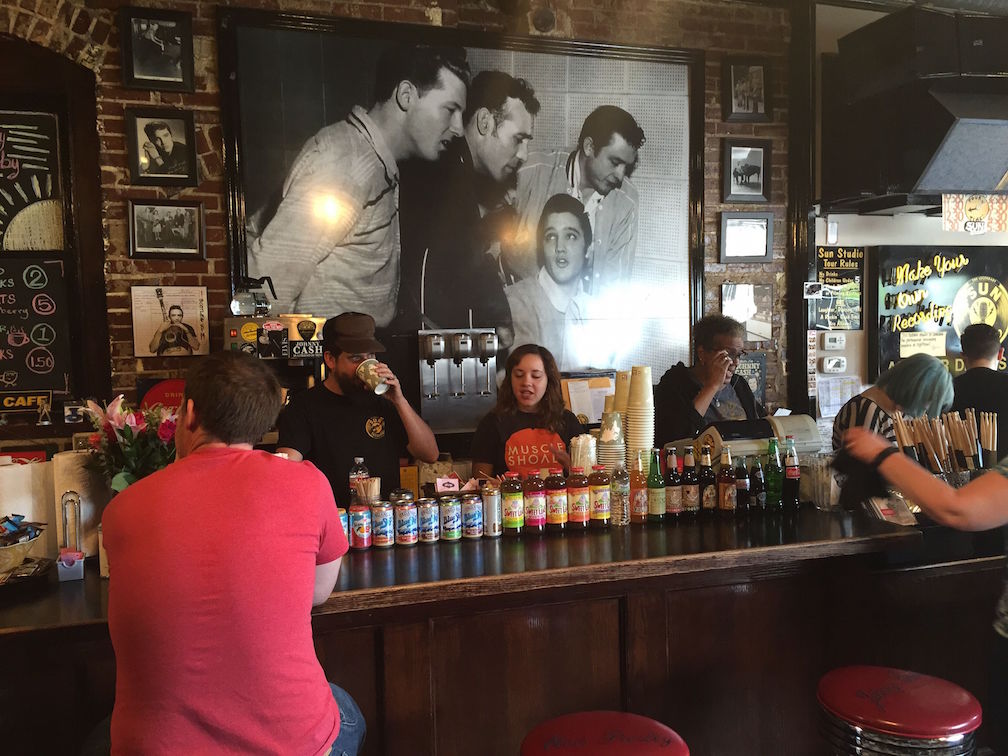 Fortunately,
there are other thriving venues in Memphis that
bespeak the city’s indelible influence on American
music. It
is never wise in Memphis to speak in less than
hushed tones about Elvis, but a visit to his
Graceland mansion sheds little light on the breadth
and depth of the city’s musical heritage. But there
are other places.
Fortunately,
there are other thriving venues in Memphis that
bespeak the city’s indelible influence on American
music. It
is never wise in Memphis to speak in less than
hushed tones about Elvis, but a visit to his
Graceland mansion sheds little light on the breadth
and depth of the city’s musical heritage. But there
are other places.
Foremost, perhaps, is Sam
Phillips’ Sun Studio,
which holds tours while still operating as a
recording studio that looks pretty much the way it
did when Jerry Lee Lewis, Carl Perkins, Elvis and
Johnny Cash recorded here. In fact, there’s a photo
behind the entrance counter (left) of the
only moment when the three of them were in the
studio together.
Carl Perkins, Roy Orbison and others made
their first recordings here, and the place is decked
out with an astounding array of memorabilia,
including rare 45 RPM wax cuttings, album covers,
microphones and guitars. (One caveat: Although I was
assured by a Sun Studio spokesperson that the
premises are "fully up to Fire Code" and has three
exits, the building is grandfathered, so there are
no water sprinklers in the often-crammed recording
studio.)
Stax Museum,
though not a recording studio (the original was torn
down), is in every way as important as Sun Studio,
for it was here that many of the greatest sounds of
soul music were created by artists like Otis Redding and Sam and
Dave. Operated by Soulsville USA, which
also operates the adjacent Stax Music Academy, this is a splendidly
modern, well-lighted museum, and its exhibits
recreate an old Southern church where the sounds of
soul germinated in gospel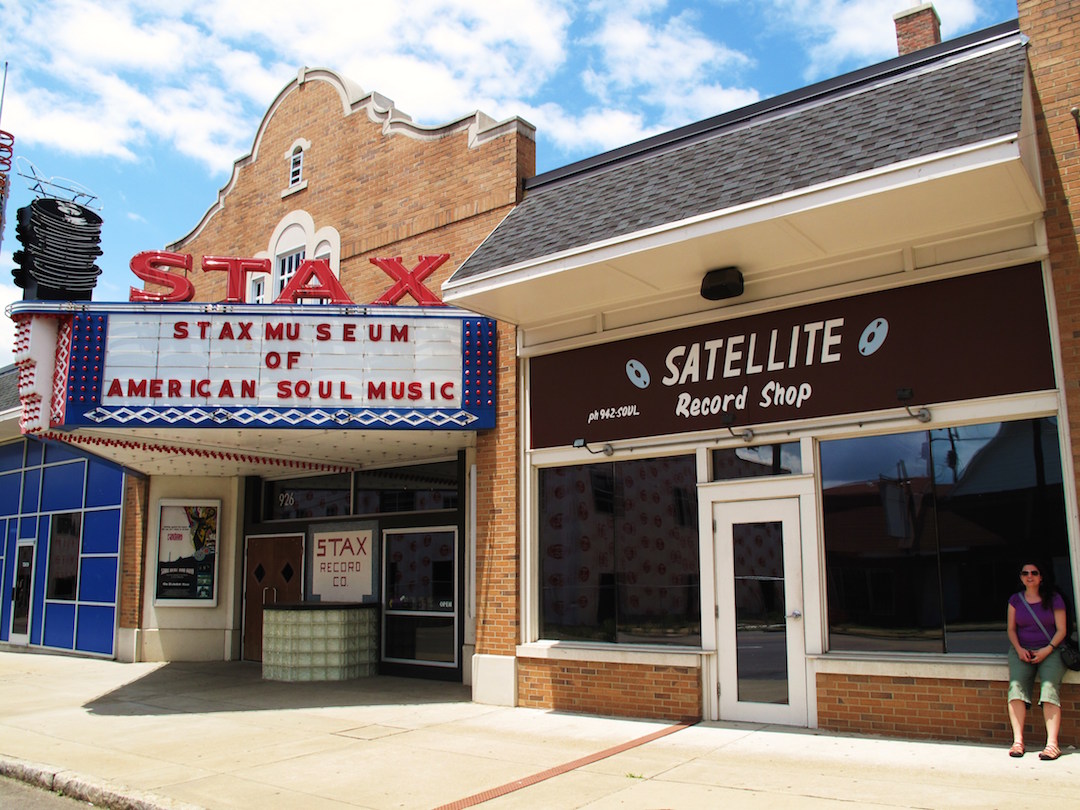 music’s
fertile spirit.
The Wall of Sound is an array of thousands of
the seminal soul music 45 RPM records through 1975,
and there is a replica of Stax’s original recording
studio, dozens of outfits and guitars of the stars,
and even the astonishingly glitzy 1972 gold-trimmed
Cadillac Eldorado that Isaac Hayes was given for the
success of his music in the movie “Shaft.”
music’s
fertile spirit.
The Wall of Sound is an array of thousands of
the seminal soul music 45 RPM records through 1975,
and there is a replica of Stax’s original recording
studio, dozens of outfits and guitars of the stars,
and even the astonishingly glitzy 1972 gold-trimmed
Cadillac Eldorado that Isaac Hayes was given for the
success of his music in the movie “Shaft.”
The beginnings of Stax were due
to Jim and Stewart and his sister Estelle Axton, founder of Satellite
records, who moved and expanded into a Memphis movie
theater in 1960 as Stax Records (a combo of their
names). The first big hit was “Cause I Love You” by
Rufus and Carla Thomas in 1960, and they kept coming
fast--Booker T and the MGs's “Green Onions,” Carla
Thomas’s “Gee Whiz,” Sam and Dave’s “Hold On, I’m
Comin’”--all of them available to listen to in the
museum, along with video recordings of the artists’
performances.
If these two
venues were not enough, there is also the Memphis
Rock n’ Soul Museum (below), on
Beale Street, set over seven galleries that document
in the most lively way the history of rock n’ roll
in all its forms, from the field hollers of 1930s
sharecroppers to the rock and soul music out of Sun
Studio and Stax, to the global reach of rock n’ roll
today. The museum’s digital audio
tour guide holds five hours of information,
including over 100 songs, and there are more than 30
instruments, 40 costumes and other musical
treasures.
T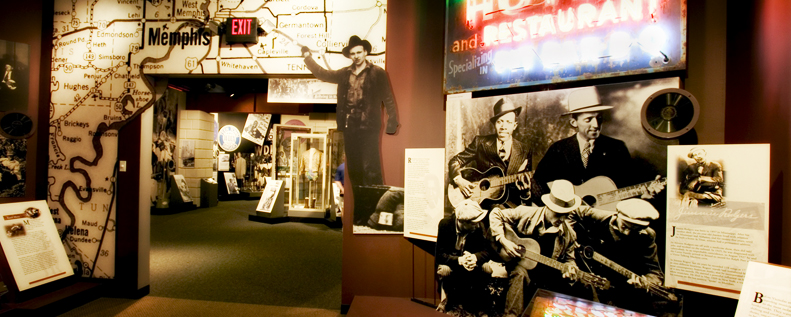 he museum was
developed in connection with Washington’s
Smithsonian Institution and the National Museum of
American History, so you know everything has been
done with impeccable credentials behind it. Certainly
equal to Cleveland’s Rock and Roll Hall of Fame and
Museum and far richer than Portland’s Rock &
Roll Hall of Fame, the Memphis institution eschews
mere spectacle in favor of true historicity.
he museum was
developed in connection with Washington’s
Smithsonian Institution and the National Museum of
American History, so you know everything has been
done with impeccable credentials behind it. Certainly
equal to Cleveland’s Rock and Roll Hall of Fame and
Museum and far richer than Portland’s Rock &
Roll Hall of Fame, the Memphis institution eschews
mere spectacle in favor of true historicity.
Not done yet? Memphis is
also home to the W.C. Handy Home &
Museum, dedicated to the “Father of
the Blues” (below)
and you can take a tour of the factory of Gibson Guitars,
which for a century has turned out the stringed
instruments that drove American music, both
acoustical and electric. 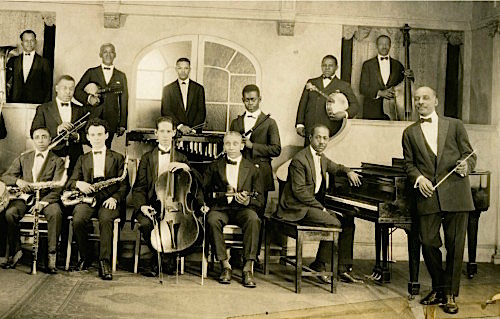
Brand new this May is the Blues Hall of Fame,
opened by the Blues Foundation, just across the
street from the National Civil Rights Museum. The hall
is committed to preserving and celebrating America’s
indigenous music, ever mindful of how many of the
great artists, like B.B. King this year, have been
lost. Induction into the Hall of Fame can be in any
of five categories: Performers,
Individuals, Classic of Blues Literature, Classic of
Blues Recording (Song), 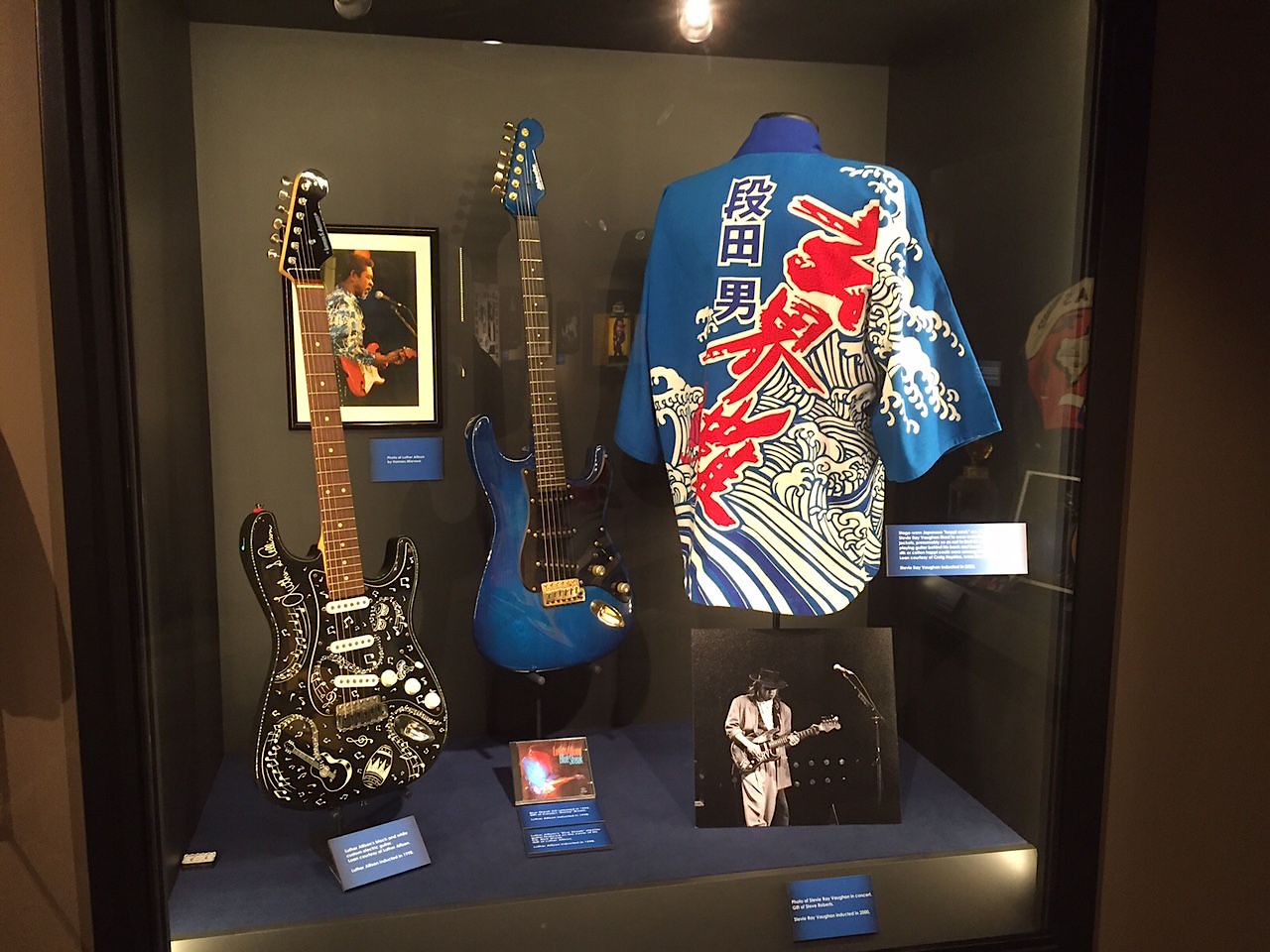 Classic of
Blues Recording (Album). The exhibits are
dazzling--that's Stevie Ray Vaughn's guitar and
shirt at left; the preservation of the music, some
of it dating back to the earliest recordings, means
we will always have it, and the sheer musicianship
and variations on the blues are staggering, from
Delta Blues (which began in Memphis) to the Chicago
Sound, the Detroit Sound, Texas Blues, West Coast
Blues and British Blues. It’s all here in rousing
profusion.
Classic of
Blues Recording (Album). The exhibits are
dazzling--that's Stevie Ray Vaughn's guitar and
shirt at left; the preservation of the music, some
of it dating back to the earliest recordings, means
we will always have it, and the sheer musicianship
and variations on the blues are staggering, from
Delta Blues (which began in Memphis) to the Chicago
Sound, the Detroit Sound, Texas Blues, West Coast
Blues and British Blues. It’s all here in rousing
profusion.
There are American
cities with more art museums and natural history
museums than Memphis, but none has the cultural
breadth and depth of museums devoted to American
musical history.
Along with Nashville’s Country Music Hall of
Fame, Tennessee can claim bragging rights no other
states dare. Now,
if Memphis can only bring back real blues and rock
to Beale Street, everything will be cool again.
❖❖❖
By John Mariani
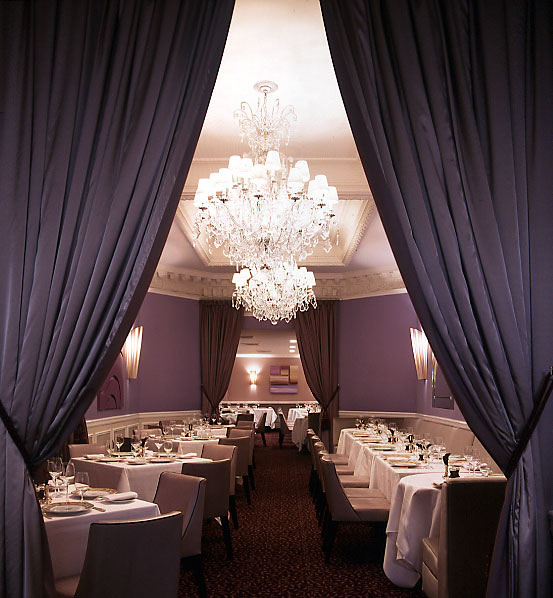 picholine
picholine35 West 64th Street (near Broadway)
212-724-8585
picholinenyc.com
Twenty-three years in
the rough and ever changing NYC restaurant world
is not just an accomplishment, it is an occasion
to put things in perspective. When
Terrence Brennan opened Picholine on the Upper
West Side, the area was not known for upscale
dining, but Brennan stirred the pot, to be
followed by Per Se, Jean-Georges, Asiate, A
Voce, Bar Boulud, Boulud Sud, Ed’s Chowder
House, Dovetail, Telepan, Lincoln Ristorante and
The Leopard at des Artistes, all playing host to
a pre-theater/concert crowd before a more
leisurely clientele arrives at eight. Thus,
anyone who carps that dining at the highest
level beyond Central Park South is improbable
has simply not eaten there at all.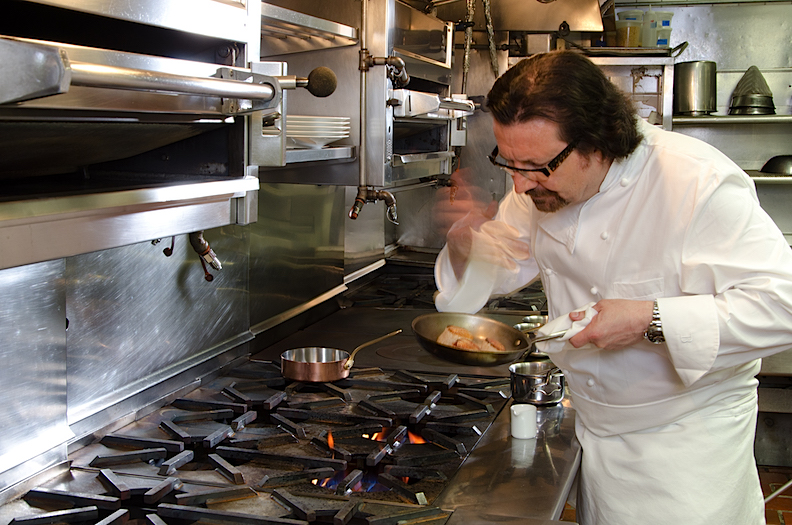
But Picholine really started the ball rolling, and
Brennan (right)
is widely recognized as one of the city's master
chefs, whose cuisine has evolved in the most
subtle and elegant way, never giving in to trends
but always watchful for what is truly innovative,
always with a Mediterranean undertone. The
wait staff is seamlessly sewn into the fabric of
refinement here, without ever crossing into rote,
the 600-label wine list, selected by Nikolis
Rouet, is as impressive as ever, and the
cheese cart, while not quite as large as it once
was, is now better focused and more user-
friendly.
You enter Picholine (named after a French olive)
from the relative quiet of West 64th Street into a
bar area--called the Salon--with a cosmopolitan
whiff of swank, a great place for a well-made
cocktail and shortened menu after work or theater. Then,
past dramatic lavender velvet curtains, you enter a
room with gray mohair banquettes,
wine-colored patterned carpet, a grand chandelier
and very comfortable chairs--all defining the best
connotations of being soigné. Beyond is another,
slightly more intimate dining room. Needless
to say, the linens, silver and stemware follow
suit.
You are presented with excellent bread and butter,
and soon come the amuses, which, on my recent
visit, included a carrot “swizzler” made from
dehydrated carrot, carrot chips, labna
cheese spread and a spice mix called dukkah; a
quail egg wrapped in brioche with caviar; and the
engaging idea of manchego cheese tempura. The
palate is indeed amused.
Along with Chef de
Cuisine Justin Urso, Brennan presents a menu that
is highly personalized but always within the
Picholine tradition of French technique with
seasonal American ingredients, never attempting to
shock the palate or confuse the senses. Thus,
there is a panna
cotta of smoked sturgeon and
(salty) wild American caviar, with beets and
apples. A
classic Italian wild mushroom risotto mixed with
pecorino acquires American sweetness from summer’s
corn and an enrichment of Australian black
truffles.
Truffles, lemon and olive oil enhance pristine,
raw, translucent Long Island fluke, and the soup
that evening was a refreshing turn on white
gazpacho, with a red gazpacho sorbet and the spark
of pimentón
chicarrón.
Ricotta agnolotti
in an artichoke barigoule
was well rendered, and the taste of bottarga
roe was mild enough, but the parsley pistou
was pushing the dish too far.
Not so the sweet Maine lobster with a radish
confit, simple sugar snap peas, and a lobster jus that,
like all Brennan’s reductions, shows how indelible
was his culinary education at restaurants like Le
Cirque in NYC (which he once called “Haute Cuisine
boot camp”) and Le Moulin de Mougins on the French
Riviera.
Mid-meal fresh napkins are brought and a lovely
objet d'art is placed on the table.
The delicacy of
halibut “en
crôute” with peas à la
française (a condiment made of pea and
onion confit, lettuce and rhubarb) and mint showed
exceptional balance of flavors that could too
easily overwhelm the others, just as in a dish of
spotted skate wing, the spicy chorizo
emulsion and Basquaise marmalade or peppers,
onions, fennel and spices buoyed the flavor
of the fish, and the paella's crispy socarrat of
rice
gave it another dimension.
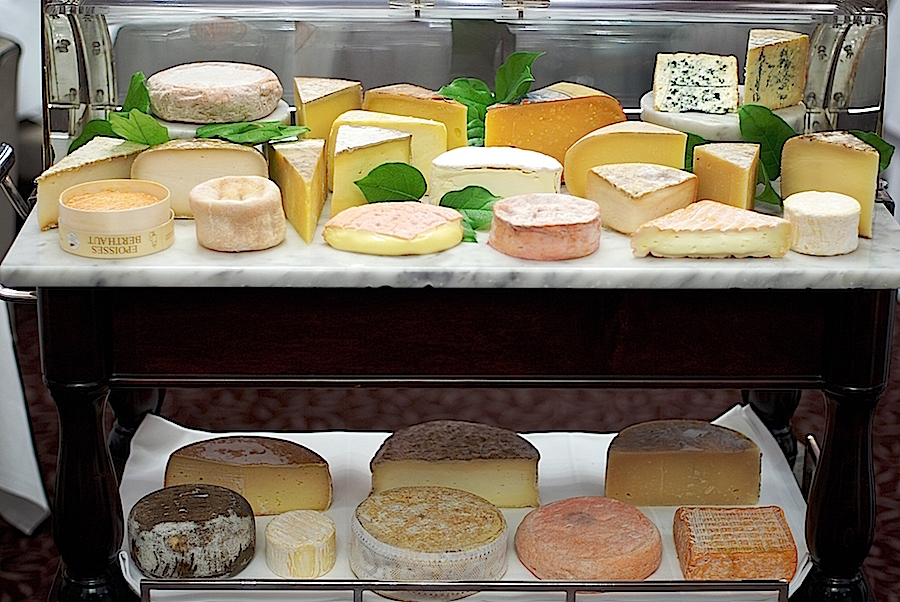 Upon seeing “Four Story Hill
suckling pig” on the menu, I feared Brennan might
follow the French tradition of packing the pig
into a roulade to no advantage, except to dry it
out; instead it was a juicy piece of slowly cooked
fatted pork with a thin sheet of crackling skin,
with the flavors of a tangy, cured torpedo onion,
sour-sweet peach mostardo
and pickled mustard seeds.
Upon seeing “Four Story Hill
suckling pig” on the menu, I feared Brennan might
follow the French tradition of packing the pig
into a roulade to no advantage, except to dry it
out; instead it was a juicy piece of slowly cooked
fatted pork with a thin sheet of crackling skin,
with the flavors of a tangy, cured torpedo onion,
sour-sweet peach mostardo
and pickled mustard seeds.
With a meal of these dimensions, it’s difficult to
save room for both cheese and dessert, but we were
helpless in resisting when the cart with two dozen
cheeses, amply described by Steve Lally,
rolled to our table. Key to serving cheeses so
that the guests’ appetites don’t flag is to cut
and plate them quickly, which they do at Picholine
with aplomb.
Desserts, by Matthew O'Haver, included a
lovely, deeply flavored dark chocolate crèmeux,
milk chocolate espuma
and white chocolate semifreddo,
and a lemon and olive tart with candied fennel,
olive oil sorbet and basil, which pretty much sum
up the consistent style of Picholine from start to
finish. Of course, sorbets, ice creams, petits
fours and chocolates ended off this grand
feast While my wife and I finished our wine,
I glanced to the vacated next
table, where a busboy was replacing the tablecloth
with a care and attention to detail--folds,
creases, equal lengths--that showed how
exquisitely well something so seemingly mundane
can be, which is the mark of a great restaurant.
A few weeks ago I
wrote of dining in Paris at L’Épicure, whose
extraordinary food and service--including a cheese
cart--I did not expect to find repeated very soon
in my travels.
But dining at Picholine was of that same
level of excellence and professionalism on every
count. What
Picholine began twenty-two years ago has only been
improved upon to serve as an inspiration to other
chefs and restaurateurs who dare not dream so high
on their own.
Picholine is open for dinner
Tues.-Sat. ; fixed price 3- course dinner $105
(a la carte and vegetarian menus also
available); pre-theater $88; 10-course tasting
menu $195; wine pairing $125.
❖❖❖
WHAT I’M
DRINKING NOW
By John Mariani
I am constantly amazed how
many well-regarded wineries can turn out such
dreadful wines.
I don’t mean the Two Buck Chuck category, I
mean the $20 and above level whose winemakers
quite obviously craft—and that’s the word—wines to
taste a certain way for a certain market. From
the days of Lancers Rosé and Blue Nun to today’s
sweet, cloying Zinfandels and wholly insipid Pinot
Grigios, wineries convinced their fans that wine
is actually supposed to taste like soda or wood
chips or sour water.
Thank heavens I have a lot of wine selections to
draw on so that, for every terrible bottle I pour
down the drain, there are several more—some
surprisingly so—that reward me with a fine
experience over lunch or dinner. And they are
almost always made by a family.
Here are some of those.
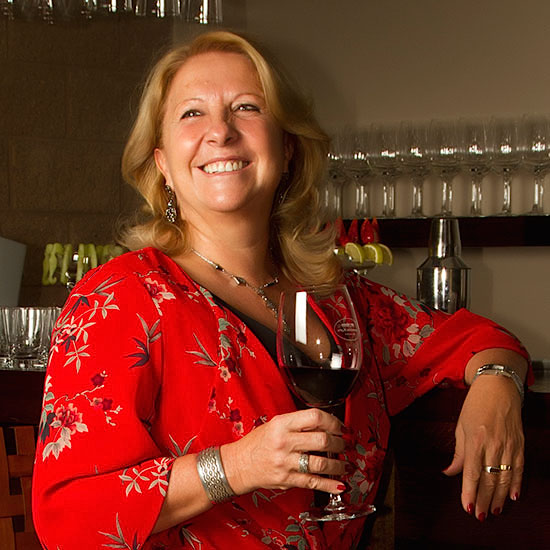 Susana Balbo Crios
Rosé of Malbec 2014 ($15)—Argentina’s first lady of
wine, Susana Balbo (left) was an enviable reputation
for her range of wines, although some of her big
reds are too massive for my taste. It was
a happy surprise, then, that this rosé made from
Argentina’s best red grape had such refinement to
it, with enough alcohol to bolster its fruit
flavors. An ideal August aperitif than can go with
any seafood that comes afterwards.
Susana Balbo Crios
Rosé of Malbec 2014 ($15)—Argentina’s first lady of
wine, Susana Balbo (left) was an enviable reputation
for her range of wines, although some of her big
reds are too massive for my taste. It was
a happy surprise, then, that this rosé made from
Argentina’s best red grape had such refinement to
it, with enough alcohol to bolster its fruit
flavors. An ideal August aperitif than can go with
any seafood that comes afterwards.
Noceto Sangiovese
2012 ($18)—Until now I’ve never had a
California Sangiovese of any distinction—at least
one winery even dared call theirs Brunello while
others ripped the grapes out--and when I picked
this from my cellar I thought, by the name, it was
Italian, for it had a very Tuscan-style Sangiovese
flavor and sensible alcohol level at 14.1%. Jim
and Suzy Gullett in Shenandoah Valley have been
working with the grape since 1987 and breeding
shows, based on vines from imported Brunello
scions. (Don’t tell anyone buy you can even buy it
in a 3-liter bag for $60.)
La Fiorita Brunello di
Montalcino Riserva 2006 ($95)—Moving quite up the vine
in Tuscany, this muscular but limber Brunello
shows all the cachet a much-abused varietal can
possess. With
14% alcohol it skirts the overripe, heady style
that has crept into the region’s winemaking. Owners
Natalie Oliveros and
Roberto Cipresso look for finesse from fairly
young vineyards called Poggio al Sole and Pian
Bosselino, with an even newer one named Podere
Giardinello.
An excellent choice for duck, goose, and
squab.
Santa Cristina 2011 ($11)—For a true Tuscan
Sangiovese, at a 13% alcohol level that makes it
always easy to drink with so many foods,  Santa Cristina is as consistent as
any commercial wine in Italy. As an
I.G.T. wine it need not follow any particular
formula, as with Chianti, but the Antinori family
(right)
guarantees the clean, versatility of a wine that
is said to use some of the same fruit as in their
D.O.C.G. Chiantis when there is an abundant
vintage. If
you like Mouton-Cadet as a French everyday wine,
you’ll like this much better as an Italian that
never disappoints.
Santa Cristina is as consistent as
any commercial wine in Italy. As an
I.G.T. wine it need not follow any particular
formula, as with Chianti, but the Antinori family
(right)
guarantees the clean, versatility of a wine that
is said to use some of the same fruit as in their
D.O.C.G. Chiantis when there is an abundant
vintage. If
you like Mouton-Cadet as a French everyday wine,
you’ll like this much better as an Italian that
never disappoints.
Fortress Cabernet
Sauvignon 2012 ($25)—The name may be brash and
its symbol of an iron gate off-putting, but this
Sonoma County
wine from an excellent vintage is very
accessible, very pleasing at 13.9% alcohol, and
its complex Bordeaux blend of 82% Cab, 7% Syrah,
3% Petit Verdot, 3% Malbec, 3% Cab Franc, and 3%
“miscellaneous” shows that winemaker Charly
dePottere is serious about getting just the right
balance with focus on terroir. It’s an
elegant wine, fairly feminine for a cab, and goes
splendidly with steak on the grill.
Inman Family
Russian River Valley Chardonnay 2013 ($35)—Kathleen Inman has always
stayed true to her reverence for refinement of
Meursault and Chablis, and you smell it
immediately in the lovely bouquet, then taste its
depth on the palate, with only a warm note of
toasted nuts that hints at a sensible aging in new
French oak.
The vintage allowed big flavors to emerge
from just 12.2% alcohol, which proves conclusively
that those California winemakers who create
bigger, oakier styles back at the winery are all
out of whack with what Chardonnay should be.
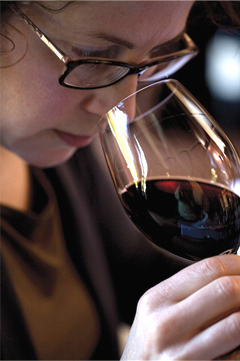
Franciscan Estates
Equilibrium White Blend 2014 ($19)—My goodness, what a
well-named blended wine! Janet Myers (left) wanted
a floral style with some nuanced tropical fruit
and nailed it with this ensemble of 72% Sauvignon
Blanc, 17% Chardonnay, and 11% Muscat, this last
really giving it an unusually aromatic quality. Pretty
is a good word for, and its ability to match up
well with seafood and poultry makes you want to
buy a case of it.
❖❖❖
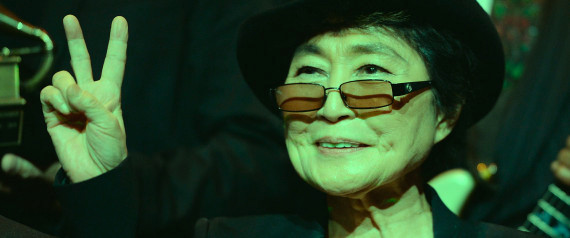
JUST DON'T CARRY THEM
IN YOUR PANTS POCKET
"Carry a bag of peas. Leave a pea wherever you go."--Yoko Ono
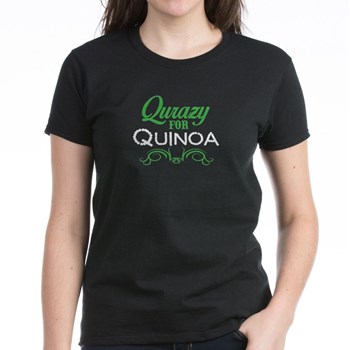
BJ’s Restaurant and Brewhouse announced
that the first family to name their child “Quinoa”
between Labor Day and October 21 of this year will be
awarded $10,000 in gift cards to BJ’s. BJ’s is
also offering rewards if you change your name to
“Quinoa” on Twitter, the restaurant will give you a $10
off $35 coupon.
\
Any of John Mariani's books below may be ordered from amazon.com.
 I'm proud and happy to announce that my
new book, The Hound
in Heaven (21st Century Lion Books), has just
been published through Amazon and Kindle.
I'm proud and happy to announce that my
new book, The Hound
in Heaven (21st Century Lion Books), has just
been published through Amazon and Kindle. It is a novella, and for anyone who loves dogs, Christmas, romance, inspiration, even the supernatural, I hope you'll find this to be a treasured favorite. The story concerns how, after a New England teacher, his wife and their two daughters adopt a stray puppy found in their barn in northern Maine, their lives seem full of promise. But when tragedy strikes, their wonderful dog Lazarus and the spirit of Christmas are the only things that may bring back his master back from the edge of despair.
WATCH THE VIDEO!
“What a huge surprise turn this story took! I was completely stunned! I truly enjoyed this book and its message.” – Actress Ali MacGraw
“He had me at Page One. The amount of heart, human insight, soul searching, and deft literary strength that John Mariani pours into this airtight novella is vertigo-inducing. Perhaps ‘wow’ would be the best comment.” – James Dalessandro, author of Bohemian Heart and 1906.
“John Mariani’s Hound in Heaven starts with a well-painted portrayal of an American family, along with the requisite dog. A surprise event flips the action of the novel and captures us for a voyage leading to a hopeful and heart-warming message. A page turning, one sitting read, it’s the perfect antidote for the winter and promotion of holiday celebration.” – Ann Pearlman, author of The Christmas Cookie Club and A Gift for my Sister.
“John Mariani’s concise, achingly beautiful novella pulls a literary rabbit out of a hat – a mash-up of the cosmic and the intimate, the tragic and the heart-warming – a Christmas tale for all ages, and all faiths. Read it to your children, read it to yourself… but read it. Early and often. Highly recommended.” – Jay Bonansinga, New York Times bestselling author of Pinkerton’s War, The Sinking of The Eastland, and The Walking Dead: The Road To Woodbury.
“Amazing things happen when you open your heart to an animal. The Hound in Heaven delivers a powerful story of healing that is forged in the spiritual relationship between a man and his best friend. The book brings a message of hope that can enrich our images of family, love, and loss.” – Dr. Barbara Royal, author of The Royal Treatment.
 |
The Encyclopedia of American Food and Drink by John F. Mariani (Bloomsbury USA, $35) Modesty forbids me to praise my own new book, but let me proudly say that it is an extensive revision of the 4th edition that appeared more than a decade ago, before locavores, molecular cuisine, modernist cuisine, the Food Network and so much more, now included. Word origins have been completely updated, as have per capita consumption and production stats. Most important, for the first time since publication in the 1980s, the book includes more than 100 biographies of Americans who have changed the way we cook, eat and drink -- from Fannie Farmer and Julia Child to Robert Mondavi and Thomas Keller. "This book is amazing! It has entries for everything from `abalone' to `zwieback,' plus more than 500 recipes for classic American dishes and drinks."--Devra First, The Boston Globe. "Much needed in any kitchen library."--Bon Appetit. |
"Eating Italian will never be the same after reading John Mariani's entertaining and savory gastronomical history of the cuisine of Italy and how it won over appetites worldwide. . . . This book is such a tasteful narrative that it will literally make you hungry for Italian food and arouse your appetite for gastronomical history."--Don Oldenburg, USA Today. "Italian
restaurants--some good, some glitzy--far
outnumber their French rivals. Many of
these establishments are zestfully described
in How Italian Food Conquered the World, an
entertaining and fact-filled chronicle by
food-and-wine correspondent John F.
Mariani."--Aram Bakshian Jr., Wall Street
Journal.
"Equal parts
history, sociology, gastronomy, and just
plain fun, How Italian Food Conquered the
World tells the captivating and delicious
story of the (let's face it) everybody's
favorite cuisine with clarity, verve and
more than one surprise."--Colman Andrews,
editorial director of The Daily
Meal.com. "A fantastic and fascinating
read, covering everything from the influence
of Venice's spice trade to the impact of
Italian immigrants in America and the
evolution of alta cucina. This book will
serve as a terrific resource to anyone
interested in the real story of Italian
food."--Mary Ann Esposito, host of PBS-TV's
Ciao
Italia. "John Mariani has written the
definitive history of how Italians won their
way into our hearts, minds, and
stomachs. It's a story of pleasure over
pomp and taste over technique."--Danny Meyer,
owner of NYC restaurants Union Square
Cafe, The Modern, and Maialino.
|
 |
 |
 |
 |
 |
 |
 |
 |
 Everett Potter's Travel Report:
Everett Potter's Travel Report: 
 Eating Las
Vegas is the new on-line site for
Virtual Gourmet contributor John A. Curtas.,
who since 1995 has been commenting on the
Las Vegas food scene and reviewing
restaurants for Nevada Public Radio.
He is also the restaurant critic for KLAS
TV, Channel 8 in Las Vegas, and his past
reviews can be accessed at KNPR.org.
Click on the logo below to go directly to
his site.
Eating Las
Vegas is the new on-line site for
Virtual Gourmet contributor John A. Curtas.,
who since 1995 has been commenting on the
Las Vegas food scene and reviewing
restaurants for Nevada Public Radio.
He is also the restaurant critic for KLAS
TV, Channel 8 in Las Vegas, and his past
reviews can be accessed at KNPR.org.
Click on the logo below to go directly to
his site.

Tennis Resorts Online: A Critical Guide to the World's Best Tennis Resorts and Tennis Camps, published by ROGER COX, who has spent more than two decades writing about tennis travel, including a 17-year stretch for Tennis magazine. He has also written for Arthur Frommer's Budget Travel, New York Magazine, Travel & Leisure, Esquire, Money, USTA Magazine, Men's Journal, and The Robb Report. He has authored two books-The World's Best Tennis Vacations (Stephen Greene Press/Viking Penguin, 1990) and The Best Places to Stay in the Rockies (Houghton Mifflin, 1992 & 1994), and the Melbourne (Australia) chapter to the Wall Street Journal Business Guide to Cities of the Pacific Rim (Fodor's Travel Guides, 1991).


MARIANI'S VIRTUAL GOURMET
NEWSLETTER is published weekly. Editor/Publisher: John
Mariani.
Editor: Walter Bagley. Contributing Writers: Christopher Mariani,
Robert Mariani, Misha
Mariani,
John A. Curtas, Edward Brivio, Mort Hochstein,
Andrew Chalk, Dotty Griffith and Brian Freedman. Contributing
Photographers: Galina Dargery, Bobby
Pirillo. Technical Advisor: Gerry McLoughlin.
To un-subscribe from this newsletter,click here.
© copyright John Mariani 2015

